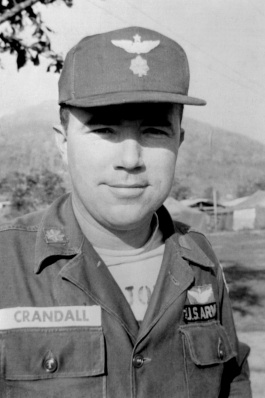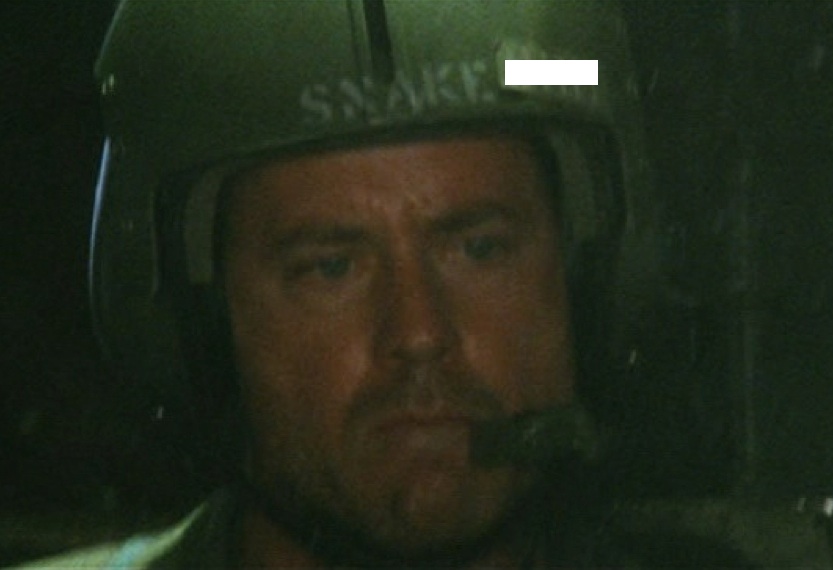In the film:
We Were Soldiers (2002)
Text of Citation:
CRANDALL, BRUCE P.
For conspicuous gallantry and intrepidity at the risk of his
life above and beyond the call of duty:
Major Bruce P. Crandall distinguished himself by extraordinary
heroism as a Flight Commander in the Republic of Vietnam, while
serving with Company A, 229th Assault Helicopter Battalion, 1st
Cavalry Division (Airmobile). On 14 November 1965, his flight of
sixteen helicopters was lifting troops for a search and destroy
mission from Plei Me, Vietnam, to Landing Zone X-Ray in the la
Drang Valley. On the fourth troop lift, the airlift began to
take enemy fire, and by the time the aircraft had refueled and
returned for the next troop lift, the enemy had Landing Zone
X-Ray targeted. As Major Crandall and the first eight
helicopters landed to discharge troops on his fifth troop lift,
his unarmed helicopter came under such intense enemy fire that
the ground commander ordered the second flight of eight aircraft
to abort their mission. As Major Crandall flew back to Plei Me,
his base of operations, he determined that the ground commander
of the besieged infantry batallion desperately needed more
ammunition. Major Crandall then decided to adjust his base of
operations to Artillery Firebase Falcon in order to shorten the
flight distance to deliver ammunition and evacuate wounded
soldiers. While medical evacuation was not his mission, he
immediately sought volunteers and with complete disregard for
his own personal safety, led the two aircraft to Landing Zone
X-Ray. Despite the fact that the landing zone was still under
relentless enemy fire, Major Crandall landed and proceeded to
supervise the loading of seriously wounded soldiers aboard his
aircraft. Major Crandall's voluntary decision to land under the
most extreme fire instilled in the other pilots the will and
spirit to continue to land their own aircraft, and in the ground
forces the realization that they would be resupplied and that
friendly wounded would be promptly evacuated. This greatly
enhanced morale and the will to fight at a critical time. After
his first medical evacuation, Major Crandall continued to fly
into and out of the landing zone throughout the day and into the
evening. That day he completed a total of 22 flights, most under
intense enemy fire, retiring from the battlefield only after all
possible service had been rendered to the Infantry battalion.
His actions provided critical resupply of ammunition and
evacuation of the wounded. Major Crandall's daring acts of
bravery and courage in the face of an overwhelming and
determined enemy are in keeping with the highest traditions of
the military service and reflect great credit upon himself, his
unit, and the United States Army.
Remarks:
Lieutenant Colonel (Retired) Bruce P. "Snake" Crandall was
presented his Medal of Honor by President George W. Bush on 26
February 2007, over 41 years after the actions for which he
earned it and 5 years after those actions were depicted by Greg
Kinnear in We Were Soldiers. [As is pointed out in the
film, the nickname "Snake" is actually an abbreviated form of a
more scatological nom de guerre, but the authors have
decided to keep this website at a PG rating. The obscuration of
the helmet in the vidcap of Greg Kinnear is for the same
reason.]
Then-Major Crandall and his close friend and second-in-command,
Captain Ed W. "Too Tall" Freeman
(portrayed in the film by Mark McCracken), have both been
awarded the Medal of Honor for leading Company A, 229th Assault
Helicopter Battalion during the Battle of Ia Drang Valley in
November 1965, the first major engagement between the US Army
and the North Vietnamese Army.
Both pilots logged 14 hours of nearly continuous flying time in
their UH-1 Iroquois (aka Huey) helicopters on 14 November 1965,
beginning with the insertion of the first wave of troops of the
1st Battalion 7th Cavalry into the clearing in the Ia Drang
Valley (which had been code-named Landing Zone X-Ray), and then
flying in reinforcements, ammunition, medical supplies, rations
and water, and flying out casualties under intense enemy fire.
The two crews are estimated to have saved the lives of some 80
wounded soldiers by assuming the Medevac role. The two men and
their crews continued to fly in and out of LZ X-Ray even after
they had allowed the other crews of Company A to stand down. The
task of medical evacuation was forced upon Company A after the
pilots of an actual Medevac unit tasked to support the operation
refused to follow Company A into the hot LZ. This resulted in a
bitter confrontation on the ground afterward when the Medevac
commander verbally blistered Crandall for leading his crews into
hostile fire; whether Crandall actually ended up pulling his
pistol on the Medevac commander as Greg Kinnear does in the film
is uncertain, but Crandall does admit to having had to be
physically restrained by his subordinate pilots at his outrage
over the Medevac commander's willingness to face him but not the
enemy.
Both Medal of Honor recommendations had previously been
downgraded to lesser awards. (One can speculate that the
above-mentioned confrontation may have come back to haunt
Crandall.) A change in regulation allowed Crandall to resubmit
Freeman's recommendation, and Freeman was awarded his medal by
President Bush in July 2001, while We Were Soldiers was
still in production. Release of the film evidently sparked
interest in the chain of command resubmitting the recommendation
for Crandall's own medal as well. (After the release of the
film, the authors were, in fact, in the process of attempting to
confirm that Lt Col Crandall had been previously nominated for
the Medal of Honor so that we could create a page on this
website on him under the Rejected Nominations category, but Lt
Col Crandall himself contacted us and specifically asked us not
to do so. We hope he forgives us for creating this
page!)
Crandall survived the Battle of Ia Drang Valley and the
remainder of his first Vietnam tour unhurt, but was severely
wounded during another heroic act on his second tour in January
1968; while searching for a downed command helicopter, his own
Huey was accidentally knocked out of the sky by "Friendly Fire"
in the form of the blasts of a US Air Force airstrike, and he
spent 5 months in the hospital with a broken back. He flew a
total of 756 missions on his two tours, received a number of
aviation awards, and retired from the Army in 1977.
The authors wish to restate (as we had originally stated on our
page on Too Tall Freeman) that we consider We Were Soldiers
to be the best Vietnam War movie ever made, and one of the
greatest war movies of all time. We are pleased that, along with
Black Hawk Down, this film
appears to be part of what we hope is a new trend in fact-based
films that stress factual/historical accuracy and faithfulness
to the original literary sources, in this case the outstanding
original 1992 book We Were Soldiers Once... and Young by
retired Lieutenant General Harold G. Moore (a Lieutenant Colonel
in command of the 1st Battalion 7th Cavalry at the time of the
action, played in the film by Mel Gibson) and Joseph L. Galloway
(a UPI correspondent at the time of the action, played by Barry
Pepper). This film doubtless further owes much of its success to
the participation of Moore, Galloway, Bruce Crandall himself
(who is credited as the aviation advisor to the film), Basil
Plumley (the Command Sergeant Major of 1st Battalion 7th
Cavalry, played in the film by Sam Elliott) and several other
veterans of the Battle of Ia Drang Valley. The authors further
recognize that even in the greatest of historical fact-based
films, such as Gettysburg, The Longest Day and Thirty Seconds Over Tokyo, the
limitations of the medium of film make the compression of time,
condensation of events, creation of composite chartacters and
the use of dramatic license unavoidable, and we do consider this
film in the same class with these others. [One of the "dramatic
license" moments, involving Crandall and Freeman, was their
participation as the close air support for the final bayonet
charge by Moore and his battalion to drive the North Vietnamese
from LZ X-Ray; the book specifically states that fixed-wing
aircraft provided the close air support, and it would have been
quite impossible for their Hueys to have been changed from
"Slick" (troop transport) configuration to "Hog" (gunship)
configuration and then back to "Slick" in the time depicted.]
Having said all that, since during most of the fighting in the
film Freeman disappears from the screen and becomes for the most
part a disembodied voice on the radio, by the same objective
criteria by which we've classified other films and depictions on
this website, the authors had to reluctantly place this film's
coverage of Too Tall Freeman in
the Blown Opportunities category, along with that of 2nd
Lieutenant Walter Joseph Marm,
who was omitted from the film and whose Medal of Honor-earning
actions were composited with the actions of 2nd Lieutenant John
L. Geoghegan (played by Chris Klein).
Next
Back to Intro
Back to Contents


